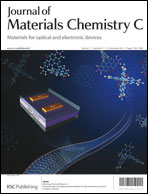Structural and luminescence properties of Eu and Er implanted Bi2O3 nanowires for optoelectronic applications
Abstract
Effective Er and Eu doping of α-Bi2O3 nanowires has been achieved by ion implantation. The nanostructures exhibit stable and efficient photoluminescence emission at room temperature after adequate annealing. X-ray photoelectron and X-ray absorption spectroscopy measurements reveal the incorporation of Er and Eu ions only in the desired trivalent charge state. The structural recovery of the implantation damage after thermal treatments was monitored by micro-Raman spectroscopy. Nanowires implanted with 300 keV ions and fluences in the range of 2 × 1015 to 8 × 1015 cm−2 show luminescence emission after annealing at 450 °C and 550 °C. Samples implanted with Eu ions show Eu3+ emission lines at 543 nm (5D1–7F1 transition), 587 nm (5D1–7F3 transition), 613 and 622 nm (5D0–7F2 transitions). Er-implanted nanowires show luminescence in the red range between 650 and 680 nm, corresponding to Er3+ 2F9/2–4I15/2 transitions. High angle annular dark field scanning transmission electron microscopy observations combined with energy dispersive X-ray microanalysis measurements reveal the formation of dopant-rich regions at higher fluences, leading to a reduced optical signal.


 Please wait while we load your content...
Please wait while we load your content...